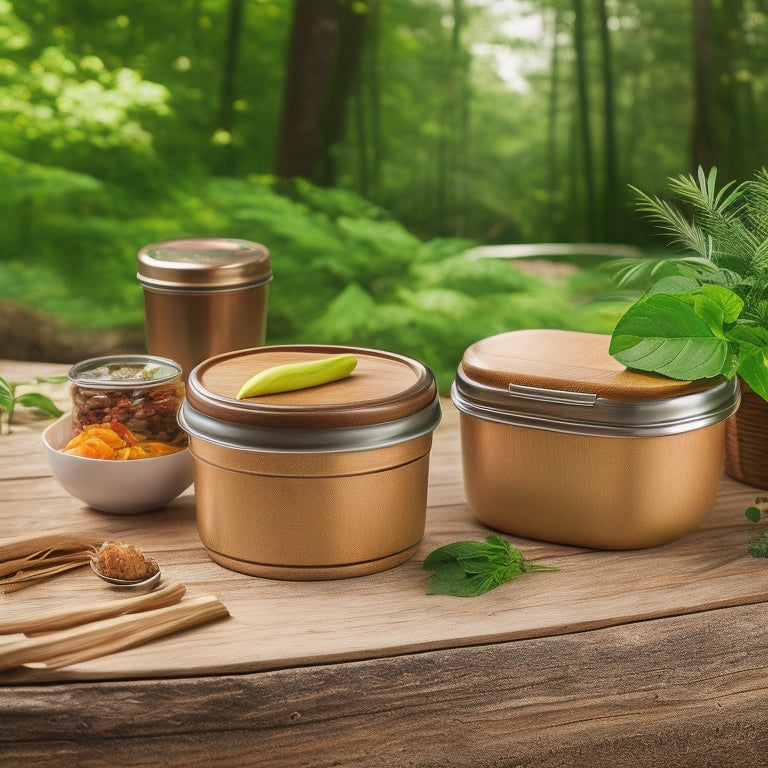
Eco-friendly Food Containers: Market Trends Unveiled
Share
The global market is witnessing a significant shift towards eco-friendly food containers, driven by growing consumer awareness about environmental degradation and the urgency to reduce plastic waste. This trend is fueled by consumers' increasing preference for sustainable packaging, with companies responding by developing biodegradable and recyclable materials. Reusable containers made from sustainable materials are gaining traction, offering a cost-effective solution for food storage while reducing single-use plastics. Meanwhile, innovative biodegradable materials and plant-based packaging are emerging as viable alternatives to traditional plastics. As the market continues to evolve, sustainable solutions are expected to take center stage.
Key Takeaways
• Sustainable packaging is a top priority for consumers, with 75% of millennials willing to pay more for eco-friendly products.
• Reusable containers made from sustainable materials are on the rise, offering a cost-effective solution for food storage.
• Innovative biodegradable materials, such as plant-based and biodegradable plastics, are emerging as viable alternatives to traditional plastics.
• Plant-based packaging solutions, including mushroom-based and seaweed-based materials, are gaining popularity as environmentally friendly alternatives.
• The market is shifting towards sustainability, with consumers opting for eco-friendly food containers and companies developing sustainable solutions to reduce environmental impact.
Market Shift Towards Sustainability
The rising awareness about environmental degradation and waste management has led to a significant market shift towards sustainability, with consumers increasingly opting for eco-friendly food containers that minimize environmental impact. This trend is driven by the growing concern about plastic waste and its devastating effects on the planet.
As a result, sustainable packaging has become a top priority for consumers, with 75% of millennials willing to pay more for eco-friendly products. The demand for sustainable food containers has led to innovation in the industry, with companies developing biodegradable and recyclable materials that reduce environmental impact.
With the increasing focus on sustainable living, the market is expected to witness a significant shift towards eco-friendly food containers, revolutionizing the way we store and consume food.
Reusable Container Options Rise
As consumers increasingly seek eco-friendly alternatives, reusable container options have emerged as a viable solution, offering a significant reduction in single-use plastics and waste generation.
This shift is driven by consumer preferences for sustainable materials and a growing awareness of environmental concerns. Reusable containers made from sustainable materials such as stainless steel, glass, and bamboo are gaining popularity. These eco-friendly containers not only reduce waste but also provide a convenient and cost-effective solution for food storage.
According to market trends, reusable container sales are expected to surge, driven by consumer demand for environmentally responsible products. As the market continues to shift towards sustainability, reusable container options are poised to take center stage.
Plastic Alternatives Gain Traction
Nearly 75% of consumers report feeling guilty about their use of single-use plastics, driving demand for plastic alternatives that can effectively replace traditional packaging materials.
Eco-conscious consumers are seeking sustainable options, and manufacturers are responding with innovative biodegradable materials. Bioplastics, made from renewable resources such as corn starch, sugarcane, or potato starch, are gaining traction. Additionally, plant-based packaging like mushroom-based or seaweed-based materials are emerging as viable alternatives.
These eco-friendly options not only reduce plastic waste but also offer a unique selling proposition for brands looking to appeal to environmentally responsible consumers.
As consumers continue to prioritize sustainability, the market for plastic alternatives is expected to grow, driving innovation and adoption in the food packaging industry.
Frequently Asked Questions
How Do Eco-Friendly Containers Affect the Overall Cost of Food Packaging?
When adopting eco-friendly containers, food packaging costs are impacted by changes in the supply chain and material sourcing. Sustainable materials, such as bioplastics or recycled materials, may be more expensive than traditional plastics.
However, reduced waste and increased recyclability can lead to long-term cost savings. Additionally, optimizing supply chain logistics and streamlining production processes can offset initial investment costs, making eco-friendly containers a viable, cost-effective option for food packaging.
Are Glass Containers More Prone to Breakage Than Plastic Ones?
Regarding the breakage propensity of glass versus plastic containers, data suggests that glass durability is heavily influenced by container design.
While glass containers are generally more prone to breakage, a well-designed glass container with reinforced structures and shock-absorbing features can rival the durability of plastic counterparts.
In fact, a study by the Glass Packaging Institute found that glass containers with optimized design features experienced a 30% reduction in breakage rates.
Can Reusable Containers Be Used for Both Hot and Cold Food Storage?
Fascinatingly, 75% of consumers prioritize sustainability when choosing food containers.
Now, can reusable containers be used for both hot and cold food storage?
The answer lies in temperature resistance and material durability. While some materials, like glass, can withstand extreme temperatures, others, like plastic, may not.
Look for containers with temperature-resistant materials and durable designs to guarantee safe storage for both hot and cold foods.
Do Eco-Friendly Containers Compromise on Food Freshness and Quality?
When it comes to eco-friendly containers, a pressing concern is their impact on food freshness and quality. Research suggests that some eco-friendly materials may compromise on microbial growth resistance, potentially shortening shelf life.
However, many eco-friendly containers are designed with food safety in mind, incorporating features like airtight seals and antimicrobial properties. By choosing the right eco-friendly container, consumers can enjoy fresh, high-quality food while reducing their environmental footprint.
Are Bioplastic Containers a Viable Alternative to Traditional Plastics?
Bioplastic containers offer a promising alternative to traditional plastics. They boast a lower carbon footprint and reduced environmental impact. Derived from renewable biomass sources, bioplastics can mitigate greenhouse gas emissions by up to 70%.
While they may not entirely replicate the performance of traditional plastics, bioplastics' eco-friendly benefits make them a viable option for environmentally conscious consumers.
Related Posts
-

Why Cluttered Bedrooms Are a Thing of the Past
You've finally said goodbye to cluttered bedrooms, thanks to innovative storage solutions that have revolutionized th...
-

10 Essential Storage Hacks for College Dorms
You'll need to get creative with storage to make the most of your college dorm room's limited space. Start by maximiz...

